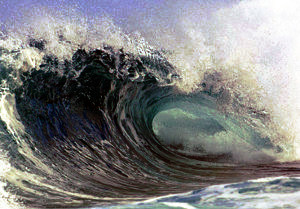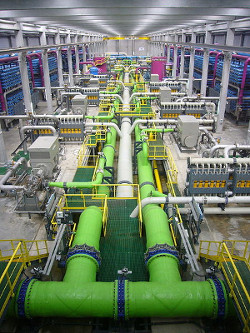The Environmental Problem Targeted
 Water stress and water scarcity are critical issues in many regions all over the world, including Europe. The available information shows that at least 10.4 % of the EU territory and 14.3 % of the EU population have been affected so far by water scarcity situations. Desalination is used in 150 countries around the world, and currently there are near 16000 desalination plants worldwide producing freshwater from both seawater and brackish water. Membrane processes have several advantages compared to the other desalination technologies such as modular construction and small footprint. These have favoured the implementation of membranes as the most used technology for water desalination.
Water stress and water scarcity are critical issues in many regions all over the world, including Europe. The available information shows that at least 10.4 % of the EU territory and 14.3 % of the EU population have been affected so far by water scarcity situations. Desalination is used in 150 countries around the world, and currently there are near 16000 desalination plants worldwide producing freshwater from both seawater and brackish water. Membrane processes have several advantages compared to the other desalination technologies such as modular construction and small footprint. These have favoured the implementation of membranes as the most used technology for water desalination.
Operating with water recoveries from 35 to 85%, desalination plants generate huge volumes of concentrates, also known as brines, containing all the retained compounds. The overall recovery of the desalination process is limited by the salinity of the concentrate stream. Higher is the brine concentration, more energy requirements will be needed and sparingly soluble salts will precipitate on membrane surface causing scaling.
Brine management in coastal desalination plants has been solved by direct discharge to the sea. In addition to the destructive saline properties of brines, during the pre-treatment processes several chemical agents are added to the feed water and all of these components are discharged along with the brine. The whole scientific community agrees that brine discharge is a potential menace for marine ecosystems, generating environmental impacts in the reception point such as diminishing the amount of flora and also creating salinity, temperature and alkalinity gradients.
 Among the five predominant angiosperms, it is worth pointing out Posidonia Oceanica and Cymodocea Nodosa. The P. Oceanica meadows have been designated as a priority habitat type to be protected in Special Areas of Conservation SACs "Posidonia beds", by the EU Directive 92/43/EEC. P. Oceanica performs several important ecological functions: fixing sand sediment on the seabed; creating a refuge and nourishment zone for reproduction and growth of diverse species; supporting epiphytes in its leaves; generating oxygen and organic matter; consuming carbon dioxide and also protecting the coast, working as a reef, against the swell waves. Due to its ecological importance and fragility, the P. Oceanica is considered one of the main habitats requiring protection in the Mediterranean Sea. C. Nodosa is another important seagrass in the Mediterranean that grows at lower depths than Posidonia and is more resistant to energetic hydrodynamics, variations in salinity and pollutant concentration. It usually covers a type of seabed that is also protected, catalogued as a SAC by the EU Directive 92/43/EEC.
Among the five predominant angiosperms, it is worth pointing out Posidonia Oceanica and Cymodocea Nodosa. The P. Oceanica meadows have been designated as a priority habitat type to be protected in Special Areas of Conservation SACs "Posidonia beds", by the EU Directive 92/43/EEC. P. Oceanica performs several important ecological functions: fixing sand sediment on the seabed; creating a refuge and nourishment zone for reproduction and growth of diverse species; supporting epiphytes in its leaves; generating oxygen and organic matter; consuming carbon dioxide and also protecting the coast, working as a reef, against the swell waves. Due to its ecological importance and fragility, the P. Oceanica is considered one of the main habitats requiring protection in the Mediterranean Sea. C. Nodosa is another important seagrass in the Mediterranean that grows at lower depths than Posidonia and is more resistant to energetic hydrodynamics, variations in salinity and pollutant concentration. It usually covers a type of seabed that is also protected, catalogued as a SAC by the EU Directive 92/43/EEC.
Regarding the management of brines in inland desalination plants, deep well injection and surface water or groundwater discharge are the most common options. In this case the impact is clearly higher than discharging the brine into the sea because of the higher concentration difference between the water source and the obtained concentrate. In case of brine discharge in surface water bodies, it can cause severe salinity problems to the water source itself but also to the adjacent soils, causing an adverse effect to the biodiversity of these regions. Discharging brines into an aquifer is also solution with very high environmental impact, so the destructive properties of brines will make the aquifer useless for future needs.
The global capacity of all desalination plants worldwide is up to 66 million m3·day-1, which involves a brine production of at least 30 million m3·day-1. In the case of the Mediterranean region growth predictions expect an increase of 180% in the desalination capacity the total global capacity is expected to reach 94 million m3·day-1 by 2015. Thus, the environmental impact generated by this technology will also increase.
The Water Framework Directive constitutes the culmination of water policy legislation within the European Union. This Directive aims to contribute to the progressive reduction of emissions of hazardous substances to water and achieving concentrations in the marine environment near background values for naturally occurring substances. The water framework directive specifies that the necessary measures to prevent deterioration of all bodies of surface water and groundwater must be implemented by national, regional and local authorities. The disposal of brine from desalination plants into water bodies is in clear conflict of the objectives of WFD. Therefore, to fulfil the objectives mentioned in this directive it is necessary to implement brine management strategies that do not include its release into the environment.
 For the case of brine disposal into the sea, the EMSFD must also be considered. This directive specifies that the necessary strategies shall be developed and implemented in order to protect and preserve the marine environment, reducing pollution and inputs on it. Again, brine disposal into the seawater is contrary to the objectives of the directive and other brine management strategies must be considered.
For the case of brine disposal into the sea, the EMSFD must also be considered. This directive specifies that the necessary strategies shall be developed and implemented in order to protect and preserve the marine environment, reducing pollution and inputs on it. Again, brine disposal into the seawater is contrary to the objectives of the directive and other brine management strategies must be considered.
Thinking about a Zero Liquid Discharge (ZLD) processes is one of the most attractive solutions to the brine environmental problem. ZLD refers to processes that fully remove water from the concentrate stream, so the end product is a solid residue of precipitate salts. In Zero Liquid Discharge Desalination, not only brines will cease to be an environmental threat, but also the recovery of the desalination process is going to reach values near the 100%. ZLD has been regarded for many years as an uneconomic solution and, therefore was employed in limited cases. However, the increasing rate of population growth, scarcity of water in many places around the globe and the growing awareness about the need for environment protection has brought this issue back to focus.
The aim of the Zelda project is to demonstrate the technically and economical feasibility of a new brine treatment system in order to decrease the total volume of brines generated and even achieve the zero liquid discharge in seawater and brackish water desalination processes, being the final objective to reduce the high environmental impact that nowadays brine discharge is causing in water ecosystems.

